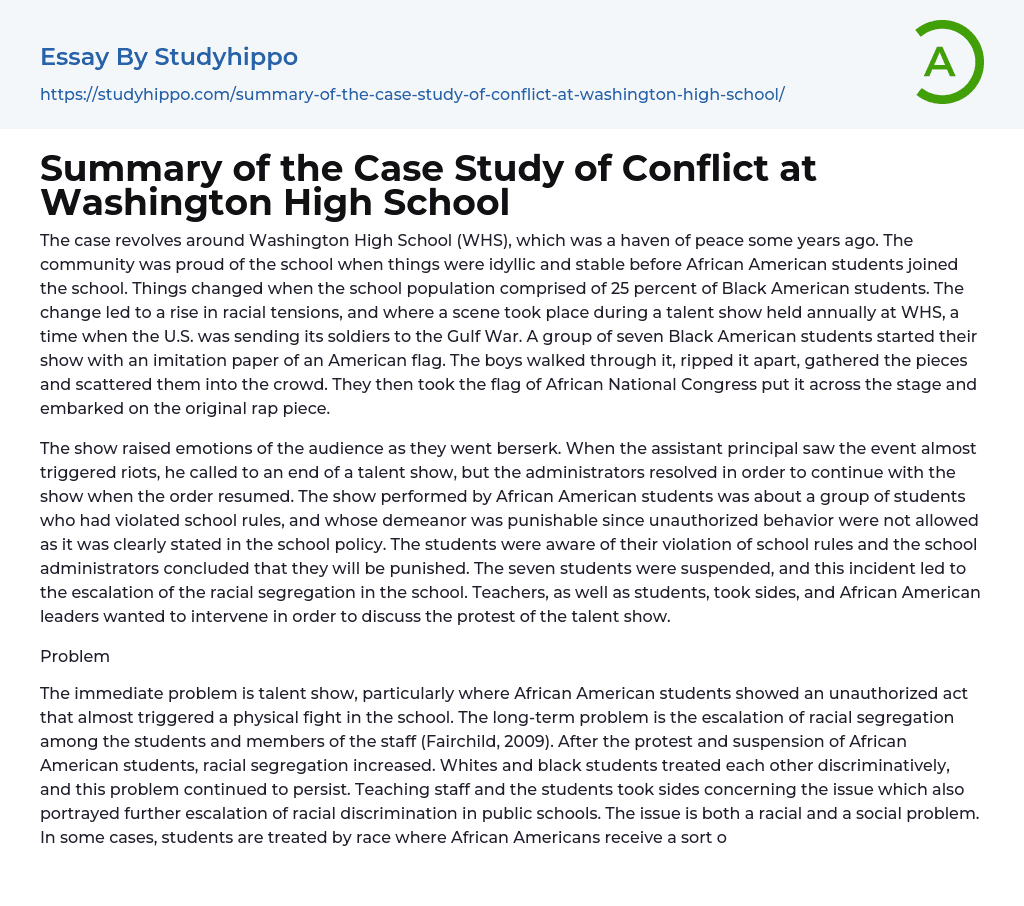

Summary of the Case Study of Conflict at Washington High School Essay Example
The case revolves around Washington High School (WHS), which was a haven of peace some years ago. The community was proud of the school when things were idyllic and stable before African American students joined the school. Things changed when the school population comprised of 25 percent of Black American students. The change led to a rise in racial tensions, and where a scene took place during a talent show held annually at WHS, a time when the U.S. was sending its soldiers to the Gulf War. A group of seven Black American students started their show with an imitation paper of an American flag. The boys walked through it, ripped it apart, gathered the pieces and scattered them into the crowd. They then took the flag of African National Congress put it across the stage and embarked on the original rap pi
...ece.
The show raised emotions of the audience as they went berserk. When the assistant principal saw the event almost triggered riots, he called to an end of a talent show, but the administrators resolved in order to continue with the show when the order resumed. The show performed by African American students was about a group of students who had violated school rules, and whose demeanor was punishable since unauthorized behavior were not allowed as it was clearly stated in the school policy. The students were aware of their violation of school rules and the school administrators concluded that they will be punished. The seven students were suspended, and this incident led to the escalation of the racial segregation in the school. Teachers, as well as students, took sides, and African American leader
wanted to intervene in order to discuss the protest of the talent show.
Problem
The immediate problem is talent show, particularly where African American students showed an unauthorized act that almost triggered a physical fight in the school. The long-term problem is the escalation of racial segregation among the students and members of the staff (Fairchild, 2009). After the protest and suspension of African American students, racial segregation increased. Whites and black students treated each other discriminatively, and this problem continued to persist. Teaching staff and the students took sides concerning the issue which also portrayed further escalation of racial discrimination in public schools. The issue is both a racial and a social problem. In some cases, students are treated by race where African Americans receive a sort of discrimination. The issue of racial discrimination affects the academic performance of students of ethnic minorities. Additionally, the problem is social since it happens in the society. Institutions such as schools and churches also engage in discriminatory practices against ethnic minorities (Hannah-Jones, 2014).The students also learn the discriminatory practices from social circles such as parents, relatives, and friends. The principal should not take the decision alone but should engage other stakeholders such as the school management, teachers, and leaders from both sides to discuss and solve the issue. The principal should meet with African-American pastor, and the agenda should be the cause of the problem and measures to curb such incidences in future.
Action Plan
The plan should start by providing education to the students and the teaching staff, and articulating a clear declaration of anticipations concerning the problem. Consequences of breaching those anticipations should be established and enforced. After the
occurrence of any racial incidence, the response ought to be fast and fair by collecting enough evidence, and the correction ought to be counteractive (Fairchild, 2009). The last step is to encourage students, teachers, community leaders and the society at large to embrace diversity in order to eliminate discriminatory practices through various programs developed to promote diversity.
Implications for Public Education
The case study shows that public education has been provided along racial lines. According to Fairchild (2009), African American students attended separate schools as they were not allowed to mix with white students. They had their classrooms as well as teaching staff. Teaching facilities for African students were not equal to the teaching facilities used by White students. They had limited classes that were congested, and they were also not provided with enough qualified teaching staff. Thus, public education was not equal since African American students did not receive a high-quality education. Inadequate teaching resources led to poor performance among African students (Reardon et al., 2012).
Effect of the Case on the School System
The case has a significant effect on the school system. It encourages the discriminatory practices where education is provided along racial lines (Hannah-Jones, 2014). Some of the groups receive a high quality education which leads to outstanding performance whereas other groups get a low quality education that affects their performance negatively. The case also affects how the school rules and disciplinary action are applied to different groups. When African American students violate the school rules, the administration acts very swiftly to take a disciplinary action against them. As Fairchild (2009) outlines, African American students receive punishment double or triple of white students. The survey
shows that the rate of suspension for African students is usually higher compared with the one for the white counterparts. Thus, the case is likely to escalate discriminative practices along racial lines in the school system.
References
- Fairchild, G. (2009). Racial segregation in the public schools and adult labor market outcomes: the case of black Americans. Small Business Economics, 33(4), 467-484. doi:10.1007/s11187-009-9202-x
- Hannah-Jones, N. (2014). Segregation Now.. Atlantic, 313(4), 68-81.
- Reardon, S. F., Grewal, E. T., Kalogrides, D., & Greenberg, E. (2012). Brown Fades: The End of Court-Ordered School Desegregation and the Resegregation of American Public Schools. Journal Of Policy Analysis & Management, 31(4), 876-904. doi:10.1002/pam.21649



